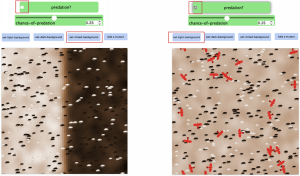This is part two of a two-part series investigating computational thinking in Biology. You can read part one by clicking here.
In the first part, I discussed what computational thinking is and why it is important for biology students to learn computational thinking. I also introduced the idea of using computational models designed as experimental model systems for engaging students in computational thinking practices. In this part, I will discuss pedagogical practices to support student engagement in specific computational thinking practices using these kinds of models.
Overview of the Rock Pocket Mice Model
To understand why certain teaching practices are beneficial to facilitate student learning with such computational models, let’s first look at how the Rock Pocket Mice model is designed and what students can do with this model. This model is designed using a multi-agent programmable modeling environment called NetLogo that allows users to easily manipulate behaviors of computational agents and investigate system-level changes.
This model is of a population of rock pocket mice. These mice are found in deserts of southwestern United States and Mexico. They are generally light-colored tiny mice. Except for the ones found in the rocky areas of deserts like those in Valley of Fires in New Mexico. There was a volcanic eruption in Valley of Fires about a thousand years ago. After the lava cooled, patches of rocky areas were formed. Interestingly, rock pocket mice in these rocky areas have dark-colored fur! How did the population of rock pocket mice change? What can we learn from this about how evolution works?
Evolutionary biologists and molecular geneticists who have been studying these mice have attributed this adaptive variation in the color of fur coat primarily to mutations in a gene called melanocortin-1-receptor gene, Mc1r. The model is based on the established scientific understanding of inheritance and predation of rock pocket mice. When students conduct computational experiments using this model, the results of these experiments are in alignment with established scientific ideas.
Some of the fundamental ideas related to natural selection that are incorporated in this model are: variation, environmental conditions, inheritance, physical traits affecting survival and reproduction.
Variation: The variation in the mouse population is in terms of the color of their fur coats, which is determined by the Mc1r gene. Users can set up the initial population using the sliders. The initial mouse population that is generated based on these settings is distributed randomly in the computational microworld. Light fur color is a recessive trait and dark fur color is a dominant trait. Users can deduce this by changing these slider values (See Figure 1).
Figure 1. Initial population of mice is created based on the slide values of homozygous dominant, heterozygous and homozygous recessive males and females
Environmental conditions: Users can set if there is predation or not in the ecosystem and the background color (See Figure 2). The desert of New Mexico has rocky dark-colored areas as well as sandy light color areas. These background colors are meant to represent the environmental conditions that affect survival mice in these habitats because of camouflage.

Figure 2. Environmental conditions can be changed in two ways – adding predators and changing the background (making it light, dark or mixed)
Inheritance: Mc1r dominant allele is responsible for dark fur color. So heterozygous phenotype is dark fur color. When a male and a female mice mate, the genotypes of the offspring are determined using the principles of Mendelian inheritance.
Physical traits affecting survival and reproduction: The probability of a mouse being predated depends on two factors, how many predators are present and how well it is camouflaged with the surroundings. A surviving mouse gets a chance to reproduce. Thus, the survival of a mouse and passing on of the traits influencing the survival results in a change in the population due to natural selection.
Because the rules of interaction of agents (inheritance of traits, camouflage etc.) are based on established biological principles, the emergent patterns that arise regarding the changes in the population are consistent with the process of natural selection. When students perform computational experiments using the phenomenon of changes in populations of rock pocket mice in different environmental conditions, they develop mechanistic explanations about natural selection.
As a biology teacher, how can I use this model in my classroom?
As a part of my PhD research, I observed teachers use this model and other similar NetLogo models in their classrooms. I also studied student learning and teaching practices to support student learning with such models. Based on my work, I noted the following effective teaching practices:
- Start with an anchoring phenomenon
The anchoring phenomenon of the Rock Pocket Mice model is explained very well in this video created by HHMI Biointeractive. Show this video to your students. Then introduce the model as an experimental model system to perform experiments to learn more about the phenomenon. Ask them what kinds of questions about the anchoring phenomenon that they can answer using the model.
- Scaffold model investigations
Student investigations of specific aspects of the phenomenon such as genotype-phenotype relationship, inheritance, predation need to be scaffolded. This is an important step before asking students to conduct their self-driven scientific investigations. This step is important for students to learn how to engage in scientific inquiry practices and computational thinking practices using a model.
- Actively facilitate peer learning
Ask a few students to share their answers and conduct a class discussion so that all the students get opportunities to learn from each other. My research shows that students share and learn both – various ways of engaging in scientific inquiry and computational thinking and various fundamental aspects of the disciplinary ideas. After conducting such class discussions, I would summarize the activity and the important learning points. I would then conduct similar investigatory and discussion activities about various aspects related to the modeled phenomenon such as predation, different environmental conditions, and changes in the population after several generations.
- Encourage self-driven scientific investigations
Finally, ask students, individually or in groups, to come up with a research question regarding the population change over time and design a computational experiment to investigate it. I would provide them with an example research question: If we introduce a mutant (with a dark-fur-coat) in a population of mice with light-fur-coats that are living in a mixed background environment, how will to population change after 500 generations? Ask students to write answers to their questions in the form of testable claims or hypotheses. Ask students to design and perform an experiment with multiple trials to collect evidence for establishing their claims. Then again ask students to share their investigations with the class. This type of iterative sharing and peer learning leads to refinement of scientific inquiry practices as well as learning of disciplinary ideas.
Final Thoughts on Using the RPM Model
The Rock Pocket Mouse model is designed as a low-threshold and high-ceiling learning environment, which means you can use it in middle school as well as graduate-level biology classes.
A curriculum embedded with such computational models makes an effective self-driven learning environment. Teachers need to support students’ self-driven learning through guiding assistance. I often design guiding questions for students to scaffold their own investigations but I also provide some direct assistance whenever it is needed. Here are three lesson plans that I co-designed for high school students to introduce the phenomenon and the model, scaffold initial investigations of specific aspects, and facilitate self-driven experimentation.
To engage Advanced Placement or University students in computational thinking practices more deeply, the scientific inquiry activities using the model can be expanded further. Students can be engaged more deeply in data practices by asking them to generate large datasets with their own experimental designs and perform systematic data analysis using statistical methods.
Students can also look at the code to discuss specific ways of modeling aspects of a phenomenon computationally, for example, inheritance or how predation based on camouflage is modeled to learn about computational problem-solving practices (lines 120, 121 and 122 of the code) (see Figure 3).

Figure 3. NetLogo provides an easy access to the code to understand and modify the underlying rules of agent behavior and interactions
Students can discuss the benefits of using such models and potential limitations. You can ask students to modify the model to incorporate new factors or overcome the limitations. This allows students to learn about computational modeling and simulation practices from an epistemological perspective.
This model can also be used to engage students in systems thinking practices, which is related to Systems and Systems Models, one of NGSS’s Crosscutting Concepts. This is an agent-based computational model. In this model, mice are the agents. Their behaviors and interactions are coded. These behaviors are about movement, survival from predation, reproduction, and inheritance of traits. The system-level changes happen at the population level because of natural selection. They are not directly coded in the model, instead, they emerge through the agent interactions. For example, it is not hard coded in the model that the dark-colored mice have a higher chance of passing on their genes in the dark environment. However, since there is a higher chance of survival of a dark mouse in the dark environment, it is more likely that two dark mice would reproduce in the dark environment and pass on the genes for dark fur color, thus changing the population of mice to be predominantly dark in the dark environment.
In this two-part Blog series, I discussed a bridge between computational sciences and biology and how Computational Thinking in biology can be taught to students. Agent-based computational models designed using NetLogo, like the Rock Pocket Mice model, are useful to develop deep understanding of a phenomenon as well as engage in a variety of Computational Thinking practices. Such interdisciplinary approaches (BRIDGES) can be highly valuable for engaging students in authentic practices of multiple disciplines. Will you try using the model and designing some curricular activities for your middle school/high school/undergraduate/graduate class? Tell me about it on Twitter @dsugat84.
Sugat is a doctoral candidate in the Learning Science program in the School of Education and Social Policies, Northwestern University. Before starting his Ph.D. program, Sugat was a computational biology researcher and a management professional. He is interested in designing curricula and pedagogical practices to deeply engage students in the construction and evaluation of knowledge. He has worked on designing and co-designing computational learning environments for high school science classrooms. Currently, he focuses on equity-centered co-design approaches for developing new curricula that leverage teachers’ and students’ context-specific funds of knowledge. He wants to extend this co-design approach to diverse local and global communities to study how technology can support such co-design efforts.
Acknowledgments:
I would like to thank the CT-STEM team, including the teachers, who have helped me develop my ideas about computational thinking and co-designing computational thinking integrated curricula. The co-designed curriculum mentioned in the blog has been developed through generous support from the National Science Foundation (grants DRL-1640201 and DRL-1842374). Any opinions, findings, or recommendations expressed in this material are those of the author(s) and do not necessarily reflect the views of the funding organizations.
